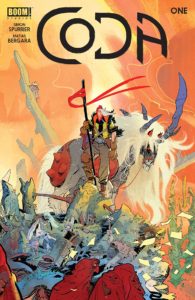 Coda #1
Coda #1
Publisher: Boom! Studios
Story: Simon Spurrier
Pencils: Matias Bergara
Inks: Matias Bergara
Colors: Matias Bergara; Michael Doig
Letters: Colin Bell
Cover: Matias Bergara
Fantasy comics are becoming the new popular thing, just like science fiction comics were a few years ago. TV series such as “Game of Thrones” drummed up interest in a genre that, while popular in other media, has never quite caught on in comics as much as superheroes, detective stories, horror, and the aforementioned science fiction.
Coda is an interesting genre-bender that combines a variety of different influences ranging from Tolkien to Mad Max. It’s a post-apocalyptic, or more properly, a post-magical world, full of non-standard creatures and humanoid species that are close to things we might recognize, but twisted enough in this world to be alien and almost repulsive. “Elves” are called “Ylves” but they are assumed to have been wiped out in the cataclysm that destroyed all magic. The main character, a wandering bard who calls himself “X” but whom others refer to as “Sir Hum”, rides what looks like a mutated unicorn, which is dubbed a “pentacorn” in the story. That X’s pentacorn also curses and has a serious case of anger issues just adds to the world building that sets this book apart from all standard fantasy tropes.
X is on a mission (definitely not a “quest”, as X mentions frequently, and which could just be a character quirk, or could refer to the magical power of words in this world) to find and rescue his love, Serka. The set-up of this issue seems to indicate that the 12-issue series will be dedicated to following X on his mission, and the different cast of characters he has to deal with to accomplish his goal. Along the way in this issue, he meets a highway bandit, a powerful and egotistical mayor who wants X to become one of her Paladin Peaceguards, and a grossly overweight mermaid diva. And this is just the first issue.
The world-building of Coda reminds me of a Dungeons & Dragons game in the depth gone to by its creators to make the world seem real and lived-in. The attention to detail to architecture, physical features, weapons, armor, and landscapes create the sense of a world that was once at a peak of civilization, but which was destroyed and trying to rebuild itself. Most D&D worlds, and most fantasy worlds, have that sense of loss and post-apocalyptic feel to them (Tolkien’s Middle Earth in the 3rd Age is but a shell of its former glory, and D&D’s Dragonlance and Dark Sun worlds, for example, are post-apocalyptic), and the world of Coda fits right in with those themes, but twists it by having the destruction of magic be the catalyst for the destruction. And, like most fantasy works, either fiction of game-related, Coda includes maps of the world in the back-matter of the comic.
Another interesting element of Coda that reminds me of role-playing games is the use of language. In this case, there’s an almost “pidgin” type language used by the inhabitants of the world that is a bit difficult to translate at first, but as you get into the rhythm of reading it, it because easier to understand so that by the end of the book, the translation comes automatically while reading. It’s very reminiscent of the “Planescape cant” manner of speech used in old D&D Planescape products.
Bergara’s art helps bring Spurrier’s world to life, and their partnership on the book, along with color assists by Michael Doig, are truly a case of what makes comics so special. While this could have perhaps been a novel, using Bergara’s unique art style to create the imagery helps the reader instantly picture the downtrodden world. This is not a setting with beautiful elves and knights in shining armor, but a gritty place full of grimy brigands, slimy politicans, and nefarious rogues all out for their own selves. The main protagonist, X, is not a good-looking guy, but a tired, worn traveler with dark circles under his eyes and a mount that could best be described as a nightmare beast. The coloring shifts between subtle, muted shades to indicate the bleakness of the world, coupled with a bright, wild palette when needed to highlight the crazier fantasy elements.
Coda provides the right mix of fantasy, comedy, action, and character development, all within an imaginative and intriguingly crafted post-apocalyptic world. The narrative device of using X’s journey to rescue Serka provides an excuse for X to explore the world of Coda, and cleverly uses Bergara’s unique art style as a way to further develop that world. This is non-traditional fantasy at its best.
Martin Thomas
martin@comicattack.net



Pingback: BOOM! Studios Reviews: Coda #4 – ComicAttack.net